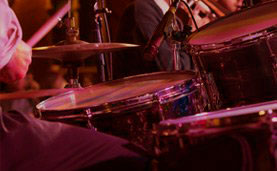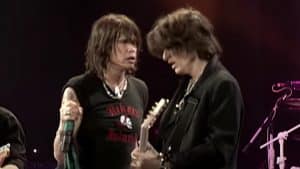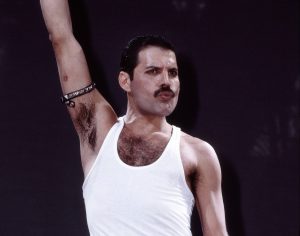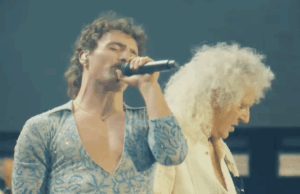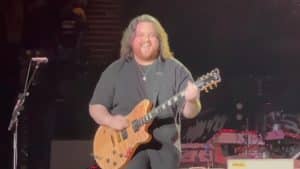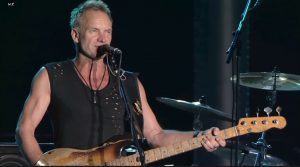15 Classic Rock Songs That Still Dominate Movie Soundtracks
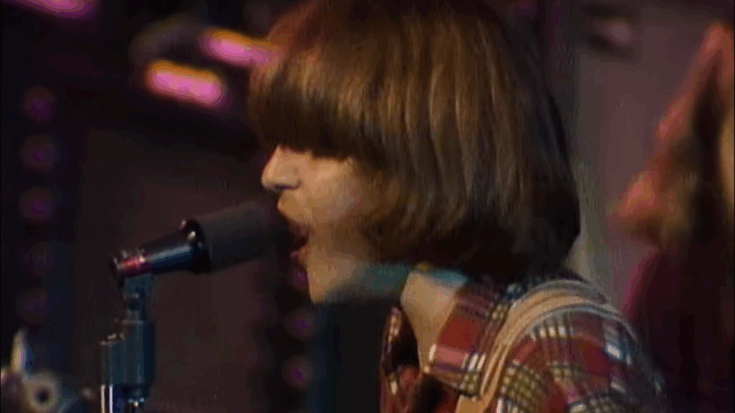
via @TheOfficialCCR / YouTube
Some songs don’t just play in movies — they become the moment. From slow-motion entrances to high-speed chases, classic rock has a way of transforming scenes into cultural landmarks. Decades after their release, these tracks continue to shape cinematic storytelling, their riffs and lyrics instantly recognizable to audiences of every generation.
Filmmakers know the emotional power of a great rock song. A few well-placed chords can define a character, set the tone, or even rescue a forgettable scene from mediocrity. That’s why directors keep turning to these timeless anthems — not just for nostalgia, but because they still hit with raw, undeniable energy that modern soundtracks rarely capture.
From Vietnam War montages to superhero blockbusters and teenage coming-of-age stories, classic rock continues to echo through Hollywood’s biggest moments. Here are 15 classic rock songs that have stood the test of time — and still dominate movie soundtracks today.
1. “Bohemian Rhapsody” – Queen
When Wayne’s World hit theaters in 1992, few could have predicted that a carload of friends headbanging to “Bohemian Rhapsody” would reignite global love for a 1975 Queen song. The moment was absurd, joyous, and unforgettable — and it brought the six-minute operatic epic roaring back into the charts, nearly two decades after its release. The song’s dramatic structure mirrored the film’s chaotic humor perfectly, turning an otherwise simple car ride into one of cinema’s most recognizable music scenes.
The sequence didn’t just make audiences laugh — it reminded the world of Queen’s theatrical genius. The song’s layered vocals, operatic crescendos, and soaring guitar solos were suddenly introduced to a new generation, transforming Wayne’s World from a comedy into a cultural time capsule. Its success even led to a resurgence in Queen’s popularity, paving the way for future revivals, including the 2018 biopic named after the song itself.
To this day, “Bohemian Rhapsody” remains a shorthand for the unfiltered joy of rock and roll on screen. It proved that a well-chosen track could transcend its original era, defining both a film and a musical legacy at once — a rare achievement that few songs have matched.
2. “Born to Be Wild” – Steppenwolf
There’s no separating “Born to Be Wild” from Easy Rider. From the moment Wyatt and Billy hit the open road on their motorcycles, the song’s opening riff became an anthem for freedom, rebellion, and the restless spirit of 1960s America. Its lyrics — “get your motor runnin’, head out on the highway” — weren’t just background noise; they were the film’s soul.
The pairing captured the countercultural shift of the late ’60s like few other moments in cinema. The film’s success made “Born to Be Wild” a generational rallying cry, with its heavy guitar riffs foreshadowing the rise of hard rock and even heavy metal. Director Dennis Hopper’s choice cemented how perfectly a song could embody a film’s themes without needing explanation.
Decades later, the track continues to symbolize cinematic freedom. Whether used in car commercials, adventure montages, or ironic cameos in animated films, “Born to Be Wild” still carries the roar of the open road — a sound that never lost its power.
3. “Stuck in the Middle with You” – Stealers Wheel
Before Reservoir Dogs, this 1972 folk-rock tune was a cheerful, catchy radio hit. After Tarantino got his hands on it, the song took on an entirely different identity. The now-infamous torture scene — with Michael Madsen’s Mr. Blonde casually dancing while committing unspeakable violence — turned “Stuck in the Middle with You” into one of the most chilling music cues in modern film history.
Tarantino’s genius lay in the contrast. The upbeat rhythm and playful lyrics created a jarring disconnect from the brutality on screen, forcing audiences to confront the absurdity and horror of the moment. That unsettling combination became a signature of his directing style, one that many filmmakers have since tried — and failed — to replicate.
The song’s legacy now belongs as much to cinema as it does to music. It’s no longer just a relic of early ’70s radio; it’s a reminder of how a film can forever reshape the emotional meaning of a song.
4. “Gimme Shelter” – The Rolling Stones
If there’s one song that defines Martin Scorsese’s brand of tension, it’s “Gimme Shelter.” Its haunting vocals and apocalyptic tone make it a natural fit for the worlds of Goodfellas, Casino, and The Departed, where betrayal, violence, and paranoia rule. Each time Scorsese uses it, the song becomes a prelude to chaos — a storm gathering over his morally crumbling characters.
The Stones originally wrote “Gimme Shelter” as a reflection on the late 1960s — a time of social unrest, war, and uncertainty. Scorsese tapped into that mood, using it to score moments that felt equally volatile and human. The track’s intensity and gospel-like wails have since become synonymous with his cinematic vision of America’s dark underbelly.
Its continued use across decades speaks to its timeless power. Few songs can evoke both beauty and dread in a single breath, but “Gimme Shelter” does it effortlessly — a musical warning that danger is always just around the corner.
5. “All Along the Watchtower” – Jimi Hendrix
Originally written by Bob Dylan, “All Along the Watchtower” became an entirely new beast in Hendrix’s hands — fierce, electric, and endlessly cinematic. It’s no wonder filmmakers gravitate toward it when depicting chaos, confusion, or transformation. In Forrest Gump, it blasts over a Vietnam War sequence that feels disorienting and intense, perfectly capturing the madness of the moment.
The song’s raw power and cryptic lyrics make it one of rock’s most adaptable soundscapes. When used in Watchmen (2009), it brought an epic, almost prophetic tone to the film’s opening montage, symbolizing both societal collapse and heroism under pressure. Hendrix’s unmistakable guitar work becomes the emotional pulse of scenes that aim to feel larger than life.
Across decades of film and television, “All Along the Watchtower” endures because it’s more than just background music — it’s a mood, a warning, and a release all at once. Its presence in a soundtrack instantly elevates the scene, proving that true classics never fade; they just find new stories to tell.
6. “Free Bird” – Lynyrd Skynyrd
The soaring guitar solo of “Free Bird” has long been a cinematic shorthand for both chaos and catharsis. Its most memorable use comes from Kingsman: The Secret Service (2014), where the song underscores a brutally choreographed church massacre scene — a violent ballet that matches the song’s escalating tempo and intensity. What was once a Southern rock anthem of freedom and defiance became, in this context, a masterclass in ironic contrast and cinematic excess.
The song’s emotional range makes it a rare piece of music that fits both tragedy and triumph. Directors often deploy it for its mix of tenderness and adrenaline — its soft piano intro easing viewers in before the guitars erupt into a wild, unforgettable finale. The track’s sheer length and progression give filmmakers room to stretch their scenes, allowing “Free Bird” to breathe and build like a narrative of its own.
Decades after its 1973 release, “Free Bird” continues to transcend its origins. Whether used earnestly or satirically, it instantly commands attention — a song that turns any scene into something larger, louder, and somehow more alive.
7. “Dream On” – Aerosmith
“Dream On” is one of those rare rock ballads that feels born for film. Its gradual climb from quiet introspection to explosive climax makes it a natural fit for moments of personal victory or emotional awakening. Featured in Vision Quest and countless other montages, it has come to represent ambition, resilience, and the long road to success.
Aerosmith’s frontman Steven Tyler wrote the song in his teens, reflecting on the desire to make something meaningful before it’s too late. That universal longing translates beautifully on screen, where characters chase dreams, face failures, or rediscover hope. The song’s cinematic power lies in that timeless message — that success comes not from winning easily, but from daring to keep going.
Over the years, “Dream On” has found new life in movies, commercials, and even sports broadcasts. No matter where it appears, the moment that soaring chorus hits, it’s impossible not to feel lifted — a reminder that even rock’s hardest edge can carry a message of perseverance.
8. “Back in Black” – AC/DC
When the first chords of “Back in Black” hit, audiences know exactly what’s coming — swagger, attitude, and unapologetic cool. Its defining cinematic moment came in Iron Man (2008), blaring as Tony Stark emerges as the cocky genius who redefines heroism on his own terms. The song didn’t just complement the scene — it became the anthem for the Marvel era’s first rock-and-roll superhero.
AC/DC’s pounding rhythm and no-nonsense guitar riff have made it a staple in action movies, sports montages, and crime thrillers alike. It’s the kind of track that instantly energizes an audience, setting the tone for confidence, speed, and chaos. The song’s rebellious spirit mirrors the larger-than-life personalities it often scores — characters who make their own rules and live fast.
More than four decades later, “Back in Black” hasn’t lost its bite. It remains the go-to soundtrack for cinematic bravado — proof that sometimes, the right riff says more than any line of dialogue ever could.
9. “Stairway to Heaven” – Led Zeppelin
For years, “Stairway to Heaven” has been one of the most mythic and untouchable songs in rock history — both for its musical complexity and for the difficulty in securing its rights for film. That’s part of why its cheeky reference in Wayne’s World remains so iconic: when Wayne starts playing its opening notes in a guitar shop only to be stopped by a “No Stairway” sign, it captured how deeply embedded the song had become in rock culture.
Though rarely used in films due to licensing, its influence still lingers across generations of directors and musicians. The song’s mystical lyrics, shifting tempo, and emotional crescendo have inspired countless cinematic moments that chase a similar sense of transcendence and discovery. Even when it’s merely referenced — not heard — it carries a weight that only legends possess.
“Stairway to Heaven” doesn’t need constant placement to dominate cinema. Its legacy hovers over every power ballad and dramatic rock montage that followed, proving that the mere idea of the song can be as powerful as the sound itself.
10. “Tiny Dancer” – Elton John
No song captures the unifying power of music quite like “Tiny Dancer” in Almost Famous (2000). After a long night of tension and ego clashes, the traveling rock band and their entourage sit in heavy silence — until Elton John’s soft piano melody begins to play. One by one, they start singing along, their resentment melting into harmony. It’s one of the most emotional, human scenes in modern film history.
Cameron Crowe, who wrote and directed the film, based the moment on his real-life experiences touring with rock bands as a teenage journalist. “Tiny Dancer,” with its gentle warmth and nostalgia, became the perfect vessel for that story — not about fame, but connection. The lyrics, originally written as a love letter to Los Angeles and the women who inspired John’s early work, take on new meaning in that cramped tour bus.
Since Almost Famous, the song has enjoyed renewed life across film and television, often used to convey healing, unity, or bittersweet reflection. It’s proof that sometimes, the quietest moments in rock are the ones that resonate longest.
11. “Old Time Rock and Roll” – Bob Seger & The Silver Bullet Band
It’s impossible to hear “Old Time Rock and Roll” without picturing Tom Cruise sliding across a hardwood floor in his socks. The Risky Business (1983) scene where a young Cruise dances in his underwear, lip-syncing to Bob Seger, became one of the most parodied and beloved moments in film history. What started as a playful bit of improvisation turned into a cultural milestone, immortalizing both the song and the movie in pop culture.
The carefree energy of the track perfectly matched the movie’s tone — rebellious, youthful, and just a little bit reckless. Cruise’s performance, full of spontaneous joy, captured the spirit of letting loose when no one’s watching. The song itself, with its nostalgic lyrics about preferring the old sounds of rock to modern trends, added a touch of irony that made the scene even more memorable.
Decades later, “Old Time Rock and Roll” remains a go-to soundtrack for scenes that need a burst of uninhibited fun. It’s not just a song; it’s a reminder of how pure, unfiltered joy can define a cinematic moment — and turn a simple scene into movie history.
12. “Don’t Stop Believin’” – Journey
Journey’s “Don’t Stop Believin’” has evolved far beyond its 1981 origins to become one of the most enduring anthems of perseverance ever recorded. Its use in The Sopranos finale brought the song renewed cultural weight, ending the series on an unforgettable note of ambiguity and emotional tension. The moment turned the song into something larger than life — a symbol of hope, resilience, and unresolved endings.
Since then, filmmakers and showrunners have leaned on its uplifting chorus to underscore moments of unity, triumph, and nostalgia. Whether in Rock of Ages, Glee, or romantic comedies that build to a collective singalong, the song’s opening piano notes are enough to send audiences into a wave of shared emotion.
Its cinematic appeal lies in its simplicity — that universal message of holding on through uncertainty. Few songs can turn both quiet reflection and full-blown celebration into equally powerful experiences, but “Don’t Stop Believin’” does it effortlessly.
13. “For What It’s Worth” – Buffalo Springfield
Released in 1966, “For What It’s Worth” has become the sonic backdrop to nearly every depiction of America’s late-’60s unrest. Its haunting opening guitar notes and Stephen Stills’ cautious lyrics — “There’s something happening here, what it is ain’t exactly clear” — have turned it into a cinematic cue for political tension and protest. Films like Forrest Gump and Born on the Fourth of July used it to instantly transport viewers into the turbulence of the Vietnam era.
The song’s subdued rhythm and reflective tone make it ideal for montage sequences and historical storytelling. It doesn’t preach; it observes. That detached calm amid chaos gives it a powerful gravity that filmmakers still rely on when exploring social upheaval or generational change.
Even decades later, “For What It’s Worth” remains one of the most effective ways to evoke the sound and spirit of an era defined by conflict and questioning. It’s less a protest anthem than a time capsule — one that still resonates with audiences facing their own moments of uncertainty.
14. “Fortunate Son” – Creedence Clearwater Revival
No song is more synonymous with the Vietnam War on film than “Fortunate Son.” From Forrest Gump to Platoon, the opening blast of John Fogerty’s voice over crashing guitars instantly signals helicopters, explosions, and the chaos of war. Its blistering tempo and anti-establishment lyrics gave it the perfect edge to underscore America’s most politically charged era.
The song’s lasting cinematic power comes from its sense of righteous anger. Fogerty’s critique of privilege — “It ain’t me, I ain’t no senator’s son” — cut straight to the divide between those who fought and those who didn’t. Directors have used it not just as background, but as commentary, a protest echoing through the lens of history.
“Fortunate Son” has appeared so often that it’s become a visual cue in itself. It embodies a specific emotional shorthand — rebellion, frustration, and truth shouted through distortion — and no matter how many times it plays, it still hits with the same raw authenticity.
15. “Eye of the Tiger” – Survivor
From the moment that unmistakable riff kicks in, “Eye of the Tiger” screams motivation. Written at Sylvester Stallone’s request for Rocky III (1982), the song became the ultimate soundtrack for determination and comeback stories. Its pounding rhythm and fierce lyrics gave life to Rocky Balboa’s underdog journey, syncing perfectly with every punch, sweat drop, and slow-motion training montage.
The song’s success was immediate and explosive, topping charts worldwide and earning Survivor a Grammy nomination. But beyond awards, its real legacy is how it reshaped the idea of what a “sports anthem” could be. Every montage, from boxing to boardrooms, owes something to its mix of grit and optimism.
Decades later, “Eye of the Tiger” still inspires energy and drive wherever it’s heard. Whether blasting in a gym, a locker room, or a climactic film sequence, it remains the defining anthem of perseverance — a song that turns every uphill battle into a cinematic moment.


